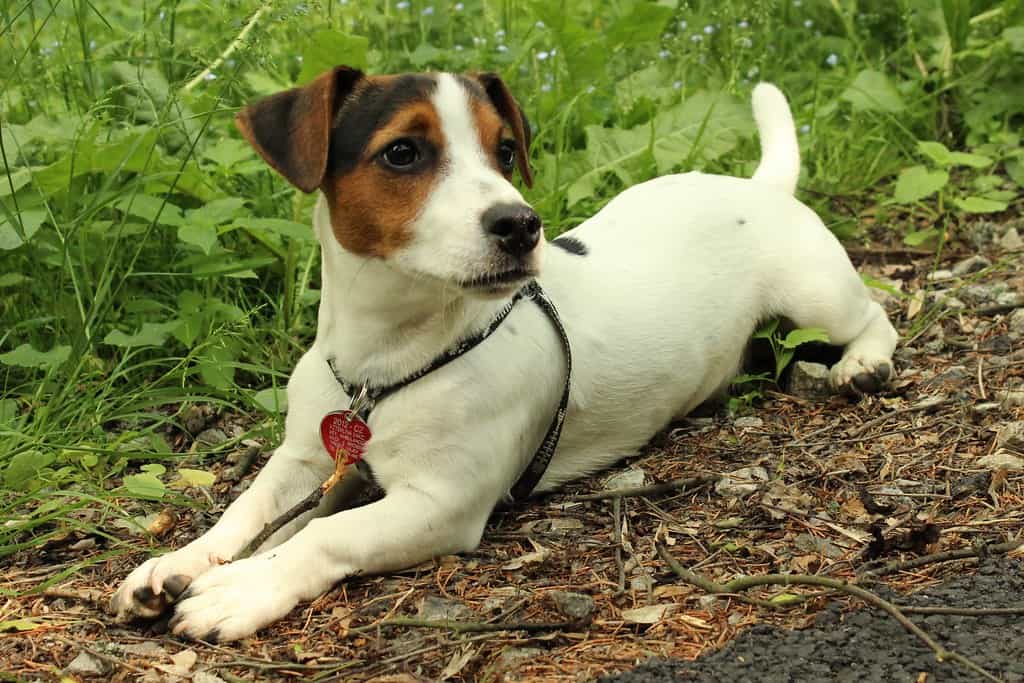Meet the Jack Russell Terrier, a breed with boundless energy and an insatiable sense of adventure. Explore their history as working dogs, uncover the care routines that keep them happy, and learn about the incredible traits that make Jack Russells such dynamic and devoted pets.

| Category (Explanation) | Breed Information |
|---|---|
| Year of Breed Conception | 19th century |
| Country of Origin | United Kingdom |
| Weight (lbs & kg) (Male) | 14-18 lbs (6-8 kg) |
| Weight (lbs & kg) (Female) | 13-17 lbs (6-7.7 kg) |
| Coat Type | Smooth or broken |
| Color Variations | Predominantly white with black or tan markings |
| Shedding Level (Low, Moderate, High) | Low to Moderate |
| Height (cm & in) | 10-12 inches (25-30 cm) |
| Breed Size | Small |
| Trainability (Low, Moderate, High) | Moderate |
| Mental Needs (Low, Moderate, High) | Moderate |
| Intelligence Level (Low, Moderate, High) | High |
| Energy Level (Low, Moderate, High) | High |
| Agility (Low, Moderate, High) | High |
| Loyalty (Low, Moderate, High) | High |
| Playfulness (Low, Moderate, High) | High |
| Exercise Needs | Regular exercise and mental stimulation |
| Guarding Proficiency (Low, Moderate, High) | Low |
| Sociability with Children (Low, Moderate, High) | High |
| Barking Level (Low, Moderate, High) | High |
| Digging Tendency (Low, Moderate, High) | High |
| Destructive Behavior (Low, Moderate, High) | Moderate |
| Drooling Level (Low, Moderate, High) | Low |
| Obedience Level (Low, Moderate, High) | Moderate |
| Apartment Friendly (Yes/No) | Can adapt to apartment living with sufficient exercise |
| Inherent Prey Drive | High |
| Physical Risk to Others (Low, Moderate, High) | Low |
| Travel Fatality Risk (Low, Moderate, High) | Low |
| Allergen Potential | Low |
| Health Concerns (List of Common Health Concerns) | Lens Luxation, Patellar Luxation, Legg-Calvé-Perthes Disease |
| Average Life Expectancy (Life Expectancy in Years) | 12-16 years |
Woof Mastery is reader supported and our articles may contain affiliate links.
Instead of running third party ads that we have no control of we only use links from high-quality companies we are directly partnered with. Making use of these links come at no cost to you our reader, and in many cases have the extra benefit of discounted rates or sign up bonuses.
If you’re interested you can read more about our affiliate policy here.
We appreciate your support and always insure that the products and services we recommend are high-quality, helpful and relevant to the subject at hand!
The Jack Russell Terrier, known for its boundless energy and adventurous spirit, has a history as a working terrier. Named after Reverend John Russell, who developed the breed in the 19th century, these terriers were originally bred for hunting foxes. Their fearless and agile nature made them perfect for this challenging task. Over the years, the Jack Russell Terrier transitioned from hunting dogs to beloved companions. Their dynamic and spirited personalities continue to shine, capturing the hearts of those who appreciate their energetic and lively character.

Jack Russell Terriers are special for their boundless energy, insatiable sense of adventure, and dynamic nature. As working dogs with a rich history, they bring vitality to their owners’ lives. Exploring their past and understanding the care they need is essential for appreciating the extraordinary traits that set Jack Russells apart as dynamic, devoted, and special pets.
The Jack Russell Terrier, named after the Reverend John Russell, has a traditional role deeply tied to its origins in fox hunting. These tenacious and energetic dogs were bred to accompany hunters on fox hunts. Their primary duty was to flush out foxes from their dens, using their small size and agility to navigate tight spaces. The Jack Russell Terrier’s role as a skilled hunting companion was instrumental in the success of fox hunts. Their dynamic and adventurous nature made them the perfect fit for this demanding task. Today, they continue to display their energetic and agile characteristics in various dog sports and as beloved family pets.
Jack Russell Terriers are full of energy and adventure. They possess dynamic and playful personalities. These terriers are known for their intelligence and tenacity. They thrive on activity and need to be mentally and physically stimulated. With the right training and activity, they can be loving and dynamic companions for active families.
Jack Russell Terriers are highly energetic and adventurous dogs. They have a dynamic and intelligent nature, making them quick learners. However, their high energy level may require an outlet, and without proper exercise and stimulation, they can become restless. Training and mental challenges are crucial to keep them happy and well-behaved. They may have a strong prey drive and may not get along with smaller pets.
Jack Russell Terriers are small, agile dogs with a well-balanced and athletic build. They have a smooth, dense, and predominantly white coat with tan, black, or brown markings. Their head is well-proportioned, with a flat skull, expressive dark eyes, and small V-shaped ears that fold forward. Jack Russells have a straight tail, which is often docked, and their legs are straight and muscular. They have a confident and determined gait, reflecting their energetic and adventurous nature.
Jack Russell Terriers come in a predominantly white coat with patches of various colors. While white is the dominant color, they can have black, tan, or brown markings. The exact coloration can vary among individuals, but their coats are typically short and smooth, making them low-maintenance in terms of grooming.
Jack Russell Terriers, also known as Parson Russell Terriers, have a low shedding level. They have a smooth or rough coat that is relatively easy to groom. Regular brushing helps minimize shedding and keeps their coat healthy. While they shed minimally, attention to their grooming needs and occasional grooming sessions contribute to reduced shedding. Overall, Jack Russell Terriers are considered to be a breed with low maintenance in terms of shedding.
Jack Russell Terriers have a smooth or rough coat that requires regular grooming to keep them clean and healthy.
Brushing: Smooth-coated Jack Russells benefit from regular brushing, about 1-2 times a week, to remove loose hair. For rough-coated Jack Russells, brushing 2-3 times a week helps prevent matting and keeps the coat in good condition.
Bathing: Occasional baths, using a mild dog shampoo, help keep the coat clean. Thoroughly rinse and dry after the bath.
Ears: Regularly check and clean their ears to prevent wax buildup or infections. Use a damp cotton ball or a veterinarian-recommended ear cleaning solution.
Nails: Keep their nails trimmed to a comfortable length, as long nails can cause discomfort and affect their gait.
Teeth: Brush their teeth regularly to maintain good oral hygiene. Dental chews or toys can also be beneficial.
Eye Care: Monitor their eyes for signs of irritation or discharge. Clean the eye area with a damp cloth if necessary.
Jack Russell Terriers have a very high activity level. These highly energetic and intelligent terriers require ample physical exercise and mental stimulation to thrive. Daily walks, playtime, and interactive games are essential for their well-being. Jack Russells excel in activities such as agility and may enjoy tasks that challenge their intelligence. Due to their energy levels, they benefit from regular exercise to prevent boredom-related behaviors. Providing them with a variety of toys and engaging activities is important for their mental and physical health.
Jack Russell Terriers are known for their intelligence, marked by problem-solving abilities, agility, and a desire to please their owners. They are generally trainable and responsive to positive reinforcement training methods. Jack Russell Terriers can learn various commands and tasks. Their agility allows them to excel in different roles, including hunting and agility sports. Historically, they were skilled in roles such as hunting, showcasing social intelligence by forming strong bonds with their families. While they may not top the charts in terms of obedience, their intelligence makes them excellent companions and working dogs. Training, socialization, and mental stimulation contribute to their well-rounded and obedient nature.
Jack Russell Terriers are known for their high energy levels and intelligence. Meeting their mental needs is essential for a well-balanced and happy dog. Here are some key considerations for their mental well-being:
Mental Stimulation: Jack Russell Terriers thrive on mental challenges. Engage them in activities such as puzzle toys, interactive games, and obedience training to keep their minds active and prevent boredom.
Social Interaction: They are social dogs and require regular interaction with their human family. Loneliness can lead to boredom-related behaviors, so provide companionship and attention.
Exercise: Physical exercise is crucial for burning off their energy, but mental exercise is equally important. Incorporate activities that challenge their problem-solving skills and keep them mentally stimulated.
Training and Obedience: Jack Russell Terriers are intelligent and respond well to positive reinforcement training. Regular training sessions not only teach them commands but also provide mental exercise and strengthen the bond between the dog and owner.
Exploration: Allow them opportunities for exploration, whether in a secure backyard or during walks. Their curious nature benefits from new experiences and environments.
Playtime: Interactive play, such as fetching and tug-of-war, provides both physical and mental exercise. Rotate toys regularly to keep them engaged and prevent boredom.
Problem-Solving: Introduce puzzle toys and games that challenge their problem-solving abilities. This mental stimulation is essential for their overall well-being.
Consistency: Maintain a consistent daily routine, including feeding, playtime, and walks. Jack Russell Terriers thrive on predictability and routine.
Enter The Woof Mastery

Prospective owners of Jack Russell Terriers should be aware of their specific characteristics and care requirements. These dogs are known for their intelligence, energy, and lively nature. Regular exercise and mental stimulation are crucial to keep them happy and prevent boredom. Potential owners should be prepared for grooming needs and committed to providing a loving, active environment. Early training and socialization contribute to their well-rounded behavior. Responsible ownership includes understanding their exercise needs and ensuring they are part of a caring family.
Jack Russell Terriers, known for their agility and intelligence, generally pose a low risk to others. Proper socialization and training contribute to positive interactions. Responsible ownership, understanding individual temperament, and adherence to local regulations play crucial roles in ensuring a well-behaved Jack Russell Terrier.
Jack Russell Terriers are known for their energetic and playful nature. They can be good with children, but supervision is important during play. Early socialization and positive reinforcement training contribute to positive interactions. Teaching children how to approach and interact with the dog is important.
Jack Russell Terriers are generally good swimmers. Their high energy levels and love for adventure may make them enjoy water activities. Introduce them to water gradually and observe their comfort level. Always prioritize safety and use a canine life vest if needed, especially in situations where they may be at risk of fatigue.
Remember that Jack Russell Terrier puppies, like all puppies, are eager to please and learn. Positive and consistent training practices will help them become well-behaved, obedient, and happy adult dogs. Building a strong and trusting bond with your puppy through training is a rewarding experience for both you and your canine companion.
Jack Russell Terriers are known for being energetic and may bark to express themselves. They have a strong prey drive and may bark when excited or stimulated. Early training and socialization are essential to manage their barking tendencies and teach them appropriate times to vocalize.
Jack Russell Terriers are adaptable and can live in various settings. They do well in homes with yards for play and exploration, but they can also adapt to apartment living with sufficient exercise. Regular walks and mental stimulation contribute to their well-being. Jack Russells enjoy being part of the family and thrive on attention. Early training and socialization help prevent behavioral issues.
When traveling with Jack Russell Terriers, consider their size, energy level, and tendency to become restless. Secure them in the vehicle using a crate or a seatbelt harness suitable for their size. Monitor for signs of stress or anxiety and provide breaks for exercise. Familiar items and positive associations with travel can help alleviate potential concerns. Plan for regular breaks during long journeys to ensure their well-being.
Jack Russell Terriers may be prone to certain health concerns, and while not all individuals will experience these issues, it’s important for owners to be aware of potential risks. Common health concerns in Jack Russell Terriers include:
Regular veterinary check-ups, a balanced diet, proper exercise, and responsible breeding practices can contribute to the well-being of Jack Russell Terriers. It’s essential for owners to monitor their dogs for any signs of discomfort or changes in behavior and seek veterinary care when needed.
Proper nutrition is essential for the health and well-being of Jack Russell Terriers. Here are some nutritional habits and best practices to consider for this breed:
Breed-Specific Laws (BSL): Jack Russell Terriers may be subject to breed-specific laws (BSL) in certain areas. These laws are often enacted at the local or municipal level and can vary widely from one jurisdiction to another.
Types of Restrictions: The specific restrictions imposed on Jack Russell Terriers under BSL can include mandatory spaying/neutering, special licensing, liability insurance requirements, muzzling in public, and, in some cases, bans on ownership. The severity of these restrictions depends on local regulations.
Rationale for BSL: BSL is typically implemented based on concerns about public safety and perceived risks associated with specific breeds, often due to incidents involving dog attacks. While Jack Russell Terriers are not inherently aggressive, they can be affected by BSL due to their physical resemblance to breeds that are sometimes included in these laws.
Controversy: It’s important to note that BSL is a controversial topic. Critics argue that it unfairly targets breeds rather than addressing individual dog behavior and that responsible ownership and training should be emphasized instead of breed-specific restrictions.
Local Regulations: To determine if there are breed-specific laws or restrictions regarding Jack Russell Terriers in your area, you should check with your local animal control or government authorities. Be aware of and comply with any local regulations to ensure that you are in compliance with the law while owning a Jack Russell Terrier.
Woof Mastery is reader supported and our articles may contain affiliate links.
Instead of running third party ads that we have no control of we only use links from high-quality companies we are directly partnered with. Making use of these links come at no cost to you our reader, and in many cases have the extra benefit of discounted rates or sign up bonuses.
If you’re interested you can read more about our affiliate policy here.
We appreciate your support and always insure that the products and services we recommend are high-quality, helpful and relevant to the subject at hand!
Myth 1: Jack Russell Terriers are Always Hyperactive
Myth 2: They are Too Small for Outdoor Activities
Myth 3: They are Not Good with Children
Myth 4: They Cannot Live in Apartments
Myth 5: They are Always Stubborn and Hard to Train
Myth 6: They are Aggressive Toward Other Dogs
Myth 7: They are All the Same in Size and Appearance
Myth 8: They are Not Good for Seniors
Myth 9: They Don’t Need Regular Grooming
Myth 10: They are Always in Need of Attention
Clarifying these myths provides a more accurate understanding of Jack Russell Terriers, allowing potential owners to make informed decisions based on the breed’s actual characteristics and needs.
Famous Jack Russell Terrier owners include:
Eddie: Perhaps one of the most famous Jack Russell Terriers, Eddie played the role of Martin Crane’s dog on the television show “Frasier.”
The Jack Russell Terrier has cultural significance in various aspects:
The Jack Russell Terrier, known for its agility and energy, gained popularity through its association with Reverend John Russell in the 19th century. While there may not be a single most famous historical owner, the breed became well-known through its working roles and appearances in literature and media.
Jack Russell Terriers, like many breeds, have encountered challenges over the years. Some notable challenges include:
The Jack Russell Terrier, renowned for its agility and hunting prowess, is believed to have been developed through a combination of terrier breeds. The contributing breeds include:
Jack Russell Terriers, with their energetic and lively nature, make charming family companions. Known for their loyalty and adaptability, they integrate well into family life. Their compact size and short coat make them suitable for various living conditions. Jack Russell Terriers thrive on companionship and engage actively in play. With proper training and socialization, they become affectionate members of the family, bringing joy and a touch of enthusiasm to the household.